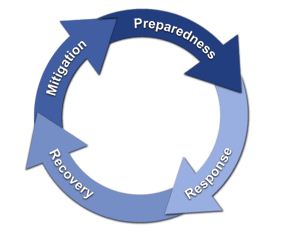WHAT IS EMERGENCY MANAGEMENT?
 Emergency management creates the framework within which communities reduce vulnerability to hazards and cope with disasters.
Emergency management creates the framework within which communities reduce vulnerability to hazards and cope with disasters.
- Mitigation
- - identify hazards and activities to prevent/lessen the impact of a disaster on lives and property
- Preparedness
- - assist individuals and communities take steps to be ready for a disaster
- Response
- - support and coordinate local agency emergency response activities
- Recovery
- - work to restore public services and return the community to normal
PRINCIPLES OF EMERGENCY MANAGEMENT
Comprehensive: emergency managers consider and take into account all hazards, all phases, all stakeholders and all impacts relevant to disasters.
Progressive: emergency managers anticipate future disasters and take preventive and preparatory measures to build disaster-resistant and disaster-resilient communities.
Risk-driven: emergency managers use sound risk management principles (hazard identification, risk analysis, and impact analysis) in assigning priorities and resources.
Integrated: emergency managers ensure unity of effort among all levels of government and all elements of a community.
Collaborative: emergency managers create and sustain broad and sincere relationships among individuals and organizations to encourage trust, advocate a team atmosphere, build consensus, and facilitate communication.
Coordinated: emergency managers synchronize the activities of all relevant stakeholders to achieve a common purpose.
Flexible: emergency managers use creative and innovative approaches in solving disaster challenges.
Professional: emergency managers value a science and knowledge-based approach based on education, training, experience, ethical practice, public stewardship and continuous improvement.
WHAT TYPE OF EMERGENCIES OR DISASTERS COULD OCCUR IN NEBRASKA?
- Blizzard or Severe Winter Storms
- Tornadoes or Severe Summer Storms
- Flooding
- Pipeline Leak
- Train Derailment
- Hazardous Material Spill or Release
- Disease Outbreak
- Earthquake
- Terrorist Event
- Wildfires
- Pandemic
WHAT CAN WE DO TO PREPARE FOR A EMERGENCY/DISASTER?
Be Informed - know what types of hazards you face and learn what to do before, during and after and emergency
Make A Plan - prepare, plan and stay informed for emergencies
Build A Kit - collect supplies and resources you may need during an emergency
Get Involed - help prepare your family, your workplace and your community. Find opportunities to support community preparedness
THINGS TO REMEBER ABOUT DISASTERS
Local Emergency Management
All disasters start at the local level.
The response is coordinated by local emergency management director.
Local governments may decide to issue a disaster declaration and request assistance from the state.
State Emergency Management
When a local disaster declaration is made because local resources have been overwhelmed, a request may be made for assistance from the Nebraska Emergency Management Agency (NEMA).
When state resources become overwhelmed, a state disaster may be declared.
Federal Emergency Management
The governor can then submit, through the Federal Emergency Management Agency, a request for a presidential disaster declaration to help the state recover.
If a presidential disaster is approved, the state is available to receive federal assistance.
EMERGENCY SUPPORT FUNCTIONS
Coordination of a state incident response is accomplished through Emergency Support Functions (ESFs). ESFs are organized groups of government and private-sector entities that provide personnel, supplies, facilities and equipment used in a response. ESFs bring together the capabilities of Nebraska’s departments and agencies and other state level assets that work together to deliver core capabilities and support for an effective response.
ESF representatives work together in the State Emergency Operation Center following a disaster to provide a coordinated state response in support of local communities that have exceeded their capacity to respond.
During a declared disaster, the Nebraska Emergency Management Act (adopted in 1996) grants the governor authority to provide for state-level support to local governments in time of extreme emergency or disaster. The governor can direct the suspension or cancellation of normal state agency operations and redirect resources as necessary. In Nebraska, the emergency support functions are numbered as follows:
- ESF 1 - Transportation
- ESF 2 - Communications
- ESF 3 - Public Works and Engineering
- ESF 4 - FIRE Suppression
- ESF 5 - Emergency Management
- ESF 6 - Mass Care, Housing and Human Services
- ESF 7 - Resource Support
- ESF 8 - Public Health and Medical Services
- ESF 9 - Urban Search and Rescue
- ESF 10 - Environmental Quality
- ESF 11 - Agriculture and Natural Resources
- ESF 12 - Energy
- ESF 13 - Public Safety and Security
- ESF 14 - Long Term Recovery and Mitigation
- ESF 15 - Military Support
The ESFs, as well as all local response entities across the state, operate within the principles of the National Incident Management System (NIMS) which incorporates principles of the Incident Command System (ICS). NIMS is a standardized system used across the nation for emergency response. Many ICS and NIMS courses are available FREE online via the Emergency Management Institute Independent Study Program: https://training.fema.gov/is/.